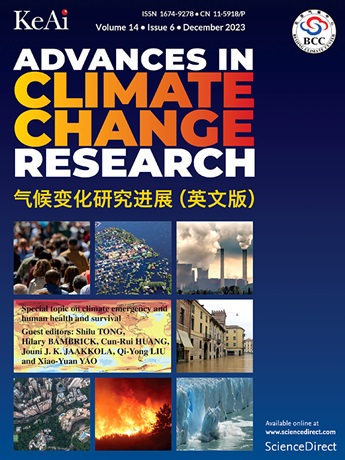Wind power correction model designed by the quantitative assessment for the impacts of forecasted wind speed error
IF 5.2
1区 地球科学
Q1 ENVIRONMENTAL SCIENCES
引用次数: 0
Abstract
The errors in wind power forecast will incur additional cost. It is critical to quantify the relationship between forecasting error in wind speed and power output. Unlike previous works that have rarely considered the speed error, we propose a comprehensive and repeatable wind power forecast correction model that quantitatively assess the impacts of speed error on power error, based on the power curves, speed predictions and distribution of speed forecast error. In this correction model, the power forecast error is obtained by calculating the mathematical expectation. The mathematical expectation of the wind power error is equal to the integral of the wind power error multiplied by its associated probability. Additionally, power forecast error and its probability are constructed as a function of speed forecast error and speed forecast error probability, respectively. To evaluate the model performance, numerical simulations are carried out in Guilin, Xiangyang and Xihai. The results suggest that the model can reduce the biases between observed and forecasted power, with the correlation coefficients increasing by over 15% in Guilin and Xihai. Furthermore, the root mean square error exhibits notable decline, with a reduction of over 35%, from 0.34 to 0.21 MW, from 0.42 to 0.27 MW and from 0.39 to 0.24 MW in the three aforementioned locations, respectively. This study contributes to enhancing the efficiency of wind power generation.
通过设计风电修正模型,对风速预报误差的影响进行定量评估
风电预测的误差将产生额外的费用。对风速预报误差与输出功率之间的关系进行量化是至关重要的。与以往很少考虑速度误差的工作不同,本文基于功率曲线、速度预测和速度预测误差分布,提出了一种全面、可重复的风电预测修正模型,定量评估速度误差对功率误差的影响。在该修正模型中,通过计算数学期望得到功率预测误差。风力误差的数学期望等于风力误差乘以其相关概率的积分。另外,将功率预测误差及其概率分别构造为速度预测误差和速度预测误差概率的函数。为了评价模型的性能,在桂林、襄阳和西海进行了数值模拟。结果表明,该模型可以减小观测值与预测值之间的偏差,桂林和西海的相关系数提高了15%以上。此外,在上述三个地点,均方根误差分别从0.34兆瓦降至0.21兆瓦、从0.42兆瓦降至0.27兆瓦和从0.39兆瓦降至0.24兆瓦,降幅超过35%。本研究有助于提高风力发电效率。
本文章由计算机程序翻译,如有差异,请以英文原文为准。
求助全文
约1分钟内获得全文
求助全文
来源期刊

Advances in Climate Change Research
Earth and Planetary Sciences-Atmospheric Science
CiteScore
9.80
自引率
4.10%
发文量
424
审稿时长
107 days
期刊介绍:
Advances in Climate Change Research publishes scientific research and analyses on climate change and the interactions of climate change with society. This journal encompasses basic science and economic, social, and policy research, including studies on mitigation and adaptation to climate change.
Advances in Climate Change Research attempts to promote research in climate change and provide an impetus for the application of research achievements in numerous aspects, such as socioeconomic sustainable development, responses to the adaptation and mitigation of climate change, diplomatic negotiations of climate and environment policies, and the protection and exploitation of natural resources.
 求助内容:
求助内容: 应助结果提醒方式:
应助结果提醒方式:


